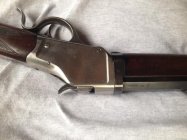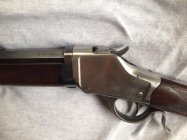I recently inherited a Schuetzen high wall in 22 Long Rifle. The rifle is absolutely beautifully weird if that makes sense. As uncomfortable as the stock looks its actually very comfy.
Onto my question. I am not sure where to find the serial number on this thing. I have disassembled the rifle down to basic components and cannot find a single mark of any kind. I took it to an older gentleman in town that knew exactly what it was and offered me an AR15 in trade on the spot....I turned him down. I have looked over the rifle under magnification and still nothing. Any help or advice would be greatly welcomed.
Very Respectfully submitted for your review
Onto my question. I am not sure where to find the serial number on this thing. I have disassembled the rifle down to basic components and cannot find a single mark of any kind. I took it to an older gentleman in town that knew exactly what it was and offered me an AR15 in trade on the spot....I turned him down. I have looked over the rifle under magnification and still nothing. Any help or advice would be greatly welcomed.
Very Respectfully submitted for your review












